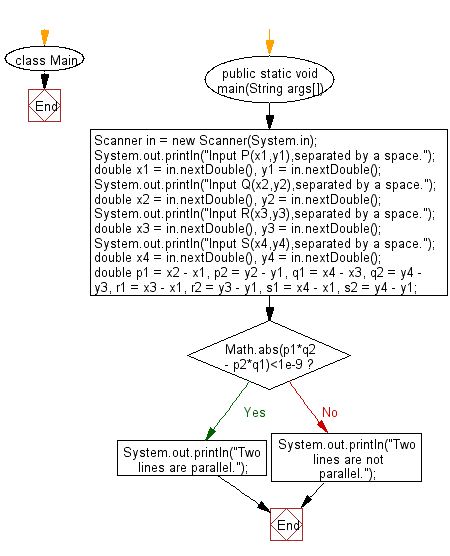Java: Test whether two lines PQ and RS are parallel
Test If Two Lines Are Parallel
Write a Java program to test whether two lines PQ and RS are parallel. The four points are P(x1, y1), Q(x2, y2), R(x3, y3), and S(x4, y4).
Input:
−100 ≤ x1, y1, x2, y2, x3, y3, x4, y4 ≤ 100
Each value is a real number with at most 5 digits after the decimal point.
Sample Solution:
Java Code:
// Importing necessary Java utilities for input
import java.util.*;
// Main class named "Main"
class Main {
// Main method to execute the program
public static void main(String args[]){
// Creating a Scanner object for user input
Scanner in = new Scanner(System.in);
// Prompting the user to input coordinates for point P(x1, y1)
System.out.println("Input P(x1, y1), separated by a space.");
double x1 = in.nextDouble(), y1 = in.nextDouble();
// Prompting the user to input coordinates for point Q(x2, y2)
System.out.println("Input Q(x2, y2), separated by a space.");
double x2 = in.nextDouble(), y2 = in.nextDouble();
// Prompting the user to input coordinates for point R(x3, y3)
System.out.println("Input R(x3, y3), separated by a space.");
double x3 = in.nextDouble(), y3 = in.nextDouble();
// Prompting the user to input coordinates for point S(x4, y4)
System.out.println("Input S(x4, y4), separated by a space.");
double x4 = in.nextDouble(), y4 = in.nextDouble();
// Calculating differences between coordinates to represent vectors
double p1 = x2 - x1, p2 = y2 - y1, q1 = x4 - x3, q2 = y4 - y3,
r1 = x3 - x1, r2 = y3 - y1, s1 = x4 - x1, s2 = y4 - y1;
// Checking if the cross product of vectors P-Q and R-S is close to zero
if(Math.abs(p1*q2 - p2*q1) < 1e-9)
// Output if the cross product is close to zero, indicating parallel lines
System.out.println("Two lines are parallel.");
else
// Output if the cross product is not close to zero, indicating non-parallel lines
System.out.println("Two lines are not parallel.");
}
}
Sample Output:
Input P(x1,y1),separated by a space. 5 6 Input Q(x2,y2),separated by a space. 4 2 Input R(x3,y3),separated by a space. 5 3 Input S(x4,y4),separated by a space. 5 6 Two lines are not parallel.
Flowchart:

For more Practice: Solve these Related Problems:
- Write a Java program to test if two lines are parallel and also check if they are collinear.
- Write a Java program to determine if two lines are parallel when given in vector form.
- Write a Java program to test if two lines are parallel by comparing their slopes computed from given points.
- Write a Java program to check if two lines are parallel using the cross product of their direction vectors.
Go to:
PREV : Sort Six Numbers in Descending Order.
NEXT : > Maximum Sum of Contiguous Subsequence.
Java Code Editor:
Contribute your code and comments through Disqus.
What is the difficulty level of this exercise?
Test your Programming skills with w3resource's quiz.
